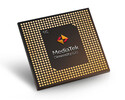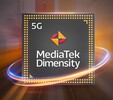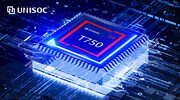MediaTek Dimensity 720 vs MediaTek Dimensity 7030 vs UNISOC T750
MediaTek Dimensity 720
► remove from comparison
The Mediatek Dimensity 720 is a mid-range SoC with an integrated 5G modem. It includes four fast ARM Cortex-A76 cores and four power efficient Cortex-A55 cores, all clocked at up to 2 GHz (Octa-Core with Heterogeneous Multi-Processing). Furthermore, the chip integrates a 3 core ARM Mali-G57 MC3 GPU, a Wi-fi 5 modem, a LPDDR4x memory controller, a AI processing unit (APU) and video de- and encoding. Compared to the faster Dimensity 820, the CPU cores are lower clocked and the GPU offers less cores. Furthermore, all other features were slightly restricted (e.g. max. 12 GB RAM).
The Dimensity 720 is manufactured in the modern 7nm process and should be very power efficient.
MediaTek Dimensity 7030
► remove from comparison
The Mediatek Dimensity 7030 is a mid-range ARM SoC (system-on-a-chip) that can be used in both smartphones and tablets (mainly Android). The SoC was introduced in September 2023.
It includes a 5G modem and supports the latest mobile phone standards in dual-SIM mode with both cards, so that surfing and phoning is possible via two different cards at the same time. The SoC integrates two ARM Cortex A78 cores with up to 2.5 GHz for demanding tasks and six low-power ARM Cortex A55 cores with clock speeds of up to 2 GHz.
The chip has an integrated sub-6 GHz and mmWave 5G modem including dual-SIM support that can reach a maximum download speed of up to 4.6 Gbps. Wi-Fi 6E (802.11ax) is supported as well as Bluetooth 5.2.
The memory controller can cope with LPDDR4x or LPDDR5 working memory as well as UFS 3.1 mass storage. As an integrated graphics card, the SoC uses the Mali-G610 MP3, which supports displays with 144 Hz as well as HDR10+ Adaptive, HLG and Dolby Vision at a maximum resolution of 2,520 x 1,080 pixels.
Compared to the Dimensity 920, the CPU unit has the same clock speeds but a more modern instruction set, ARMv8.2-A. A new graphics unit is used and WiFi 6E is supported, as well as displays with up to 144 Hz.
The SoC is manufactured in a 6nm process.
UNISOC T750
► remove from comparison
The Unisoc T750 (Tanggula, former Spreadtrum) is a mid range SoC for Android based smartphones and tablets. It integrates an octa-core CPU with two clusters. Two fast ARM Cortex-A76 cores clocked at up to 2 GHz and six small ARM-Cortex-A55 cores at again up to 1.8 GHz for efficiency. The faster T760 SoC offers two more A76 cores, a faster GPU and a faster memory controller.
The integrated memory controller supports LPDDR4X with up to 1866 MHz. The integrated ISP supports two main cameras (up to 64 MPix). The integrated graphics card is an ARM Mali-G57 MC2 (2 cores) at up to 680 MHz. The integrated modem supports Wi-Fi 5 WLAN, 5G (TDD+FDD CA Sub-6GHz), and Cat15DL / Cat18 UL LTE.
The chip is manufactured in the modern 6nm process.
| Model | MediaTek Dimensity 720 | MediaTek Dimensity 7030 | UNISOC T750 |
| Codename | Cortex-A76 / A55 | Cortex-A78 / A55 | Cortex-A76 / A55 |
| Clock | 2000 MHz | 2000 - 2500 MHz | 1800 - 2000 MHz |
| Cores / Threads | 8 / 8 | 8 / 8 2 x 2.5 GHz ARM Cortex-A78 6 x 2.0 GHz ARM Cortex-A55 | 8 / 8 2 x 2.0 GHz ARM Cortex-A76 6 x 1.8 GHz ARM Cortex-A55 |
| Technology | 7 nm | 6 nm | 6 nm |
| Features | 4x ARM Cortex-A76 (2 GHz), 4x ARM Cortex-A55 (2 GHz), ARM Mali-G57 MC3, APU 3.0, 5G Modem, MiraVision (4K30 Video, 64MP Photo), Wi-Fi 5, Bluetooth 5.1, UFS 2.2, 12GB LPDDR4x Support | 2x ARM Cortex-A78 (2.5 GHz), 6x ARM Cortex-A55 (2 GHz), ARM Mali-G610 MC3, 5G Sub-6 GHz, LTE | 5G, LTE, ISP (up to 64MPixel), eMMC 5.1, UFS 3.1, LPDDR4X 1866MHz, LTE, GPS, Glonass, Beidou, Galileo, 802.11 b/g/n/ac, Bloetooth 5.0, FM-Radio, TEE Security |
| iGPU | ARM Mali-G57 MP3 | ARM Mali-G610 MP3 | ARM Mali-G57 MP2 ( - 680 MHz) |
| Architecture | ARM | ARM | ARM |
| Announced | |||
| Manufacturer | www.mediatek.com | www.mediatek.com | |
| L3 Cache | 3 MB |
Benchmarks
Average Benchmarks MediaTek Dimensity 720 → 100% n=4
Average Benchmarks MediaTek Dimensity 7030 → 151% n=4
Average Benchmarks UNISOC T750 → 99% n=4
* Smaller numbers mean a higher performance
1 This benchmark is not used for the average calculation











